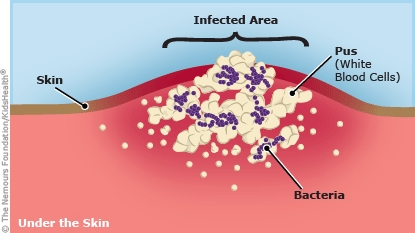Your child has an infection of their skin. The infection is caused by a bacteria (germ) commonly known as MRSA (methicillin-resistant Staphylococcus aureus). MRSA is a type of bacteria that doesn't respond to the antibiotics usually used to treat staphylococcal infections. This can make MRSA (MUR-suh) infections harder to treat, but most will heal quickly with proper care.
MRSA infections are contagious and can spread easily among those in close contact. Here's how to care for your child and prevent the spread of MRSA.


Follow your health care provider's recommendations for:
To help prevent the spread of MRSA from the infection:



How do MRSA skin infections happen? Staph bacteria, including MRSA, often live on skin or in the nose without causing any problems. Infections can happen if the bacteria enter the body through a wound, insect bite, or other area of broken skin. Sometimes, an infection can happen even when there isn't a break in the skin. Infections are also more likely if a child was in close contact with another person who has MRSA.
Can my child go to school or daycare? Your child can go to school or daycare if you keep the area covered with a clean, dry bandage. If you are not able to keep the area covered, ask your health care provider when your child can go back to school or daycare. This is usually when the area stops draining fluid.
How do bacteria like MRSA become resistant to antibiotics? Bacteria become resistant to antibiotics when the medicines are not used properly. This happens when people:
Taking antibiotics exactly as prescribed can help stop bacteria from becoming resistant.